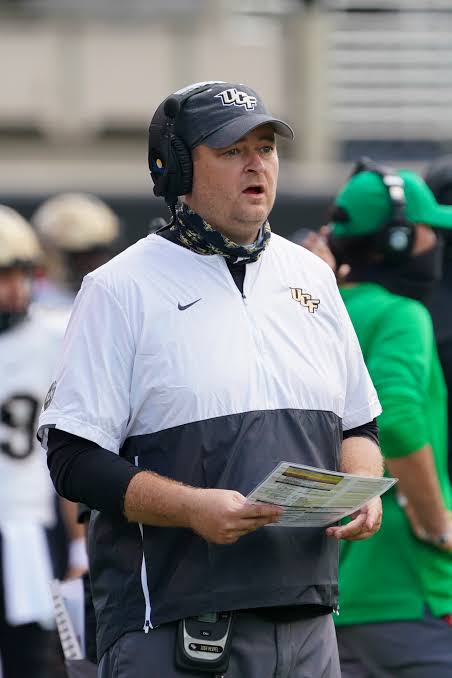Breaking News: John Heupel’s Innovative Quarterback Strategy Transforms Tennessee’s Offense….
Knoxville, TN –In a bold move that has captured the attention of college football fans and analysts alike, Tennessee Volunteers head coach John Heupel has implemented a dynamic offensive strategy that features a three-quarterback rotation. This approach, which gained momentum during the last season, not only showcased the individual talents of each quarterback but also allowed the team to remain unpredictable in high-stakes games.
The Rationale Behind the Rotation
Heupel, known for his offensive prowess, recognized the need to adapt to the evolving landscape of college football. By rotating quarterbacks, he aimed to leverage the unique strengths of each player. “In today’s game, versatility is key,” Heupel stated in a recent press conference. “By using multiple quarterbacks, we can keep our opponents guessing while maximizing our offensive potential.”
The decision to utilize a three-quarterback system stemmed from a combination of factors, including injuries to key players and the need for depth in the lineup. The approach allowed Heupel to maintain a high-paced offense without sacrificing performance, ensuring that each quarterback could contribute effectively.
The Quarterbacks: A Closer Look
Last season, the Volunteers featured a talented trio of quarterbacks: starter Joe Milton, the agile and dynamic Hendon Hooker, and the promising freshman, Nico Iamaleava. Each brought unique skills to the table, allowing Heupel to tailor his game plan to exploit defensive weaknesses.
Joe Miltonemerged as the primary starter, known for his powerful arm and deep passing ability. His experience allowed him to lead the offense, making critical decisions in clutch situations. However, Heupel was quick to emphasize that Milton’s role was not solely as the centerpiece of the offense.
Hendon Hooker provided a different dimension with his dual-threat capabilities. His ability to run the ball effectively made him a constant threat, forcing defenses to adapt. Hooker’s mobility and quick decision-making allowed Tennessee to capitalize on mismatches, especially in zone coverage.
Nico Iamaleava, the freshman, injected youthful energy and creativity into the lineup. Though less experienced, his raw talent and playmaking ability earned him valuable snaps. Heupel was particularly impressed with Iamaleava’s quick learning curve and adaptability, seeing him as a future cornerstone of the program.
Game Strategy: Keeping Opponents Guessing
Heupel’s offensive philosophy revolves around speed and unpredictability. By rotating quarterbacks, he created a fast-paced environment that kept defenses off balance. Each quarterback’s unique skill set allowed for a varied playbook, with different formations and strategies implemented based on who was under center.
This strategy became especially effective in critical games against conference rivals. For instance, during a matchup against Alabama, Heupel utilized all three quarterbacks, mixing passing plays with designed runs. The result was a high-scoring affair that showcased Tennessee’s offensive versatility, ultimately leading to a narrow victory that surprised many pundits.
The Impact on Team Dynamics
The three-quarterback system also had significant implications for team dynamics. Rather than creating competition or jealousy among the quarterbacks, Heupel fostered a collaborative environment. The quarterbacks often met together to discuss strategies, share insights, and support one another. This camaraderie was evident during games, as players cheered each other on from the sidelines and remained engaged throughout.
Moreover, the system allowed the coaching staff to develop each quarterback’s skills without overwhelming them. By sharing the load, Heupel minimized the risk of burnout, ensuring that each player remained fresh and ready to perform.
Fan Reactions and Future Implications
Fans have responded positively to Heupel’s innovative approach, showing enthusiasm for the team’s dynamic offensive plays. Attendance at games surged, with supporters eager to see how the quarterbacks would perform in each matchup. Social media buzzed with excitement as fans debated the strengths and weaknesses of each player, highlighting the increasing engagement and investment in the program.
Looking ahead, Heupel’s strategy may set a precedent for other college programs. As more teams recognize the benefits of utilizing multiple quarterbacks, we could see a shift in how offensive schemes are designed across the country. Heupel’s success could inspire similar tactics, emphasizing flexibility and adaptability in game planning.
Challenges and Criticisms
Despite the success of the three-quarterback system, it has not been without its challenges. Critics argue that constant rotation can disrupt a quarterback’s rhythm, making it difficult for them to establish a cohesive connection with their receivers. However, Heupel has countered this by emphasizing the importance of practice and preparation. “Our players put in the work during the week, and that consistency helps us in games,” he explained.
Additionally, there is the concern of over-reliance on a single strategy. As the upcoming season approaches, opponents will have had time to analyze Tennessee’s tactics and prepare countermeasures. Heupel’s ability to adapt and evolve the offensive scheme will be critical in maintaining an edge.
Conclusion
John Heupel’s innovative approach to quarterback management has reinvigorated the Tennessee Volunteers’ offense, transforming them into a formidable contender in college football. By effectively utilizing a three-quarterback system, Heupel has not only maximized the potential of his players but also created an engaging and unpredictable style of play that has captured the attention of fans and analysts alike.
As the Volunteers prepare for the upcoming season, all eyes will be on Heupel and his quarterbacks to see how they adapt and evolve their strategies. The future looks bright for Tennessee, and the excitement surrounding the program is palpable. Whether or not the three-quarterback system will remain a staple in college football remains to be seen, but one thing is clear: John Heupel is not afraid to push boundaries and redefine the norms of the game.



